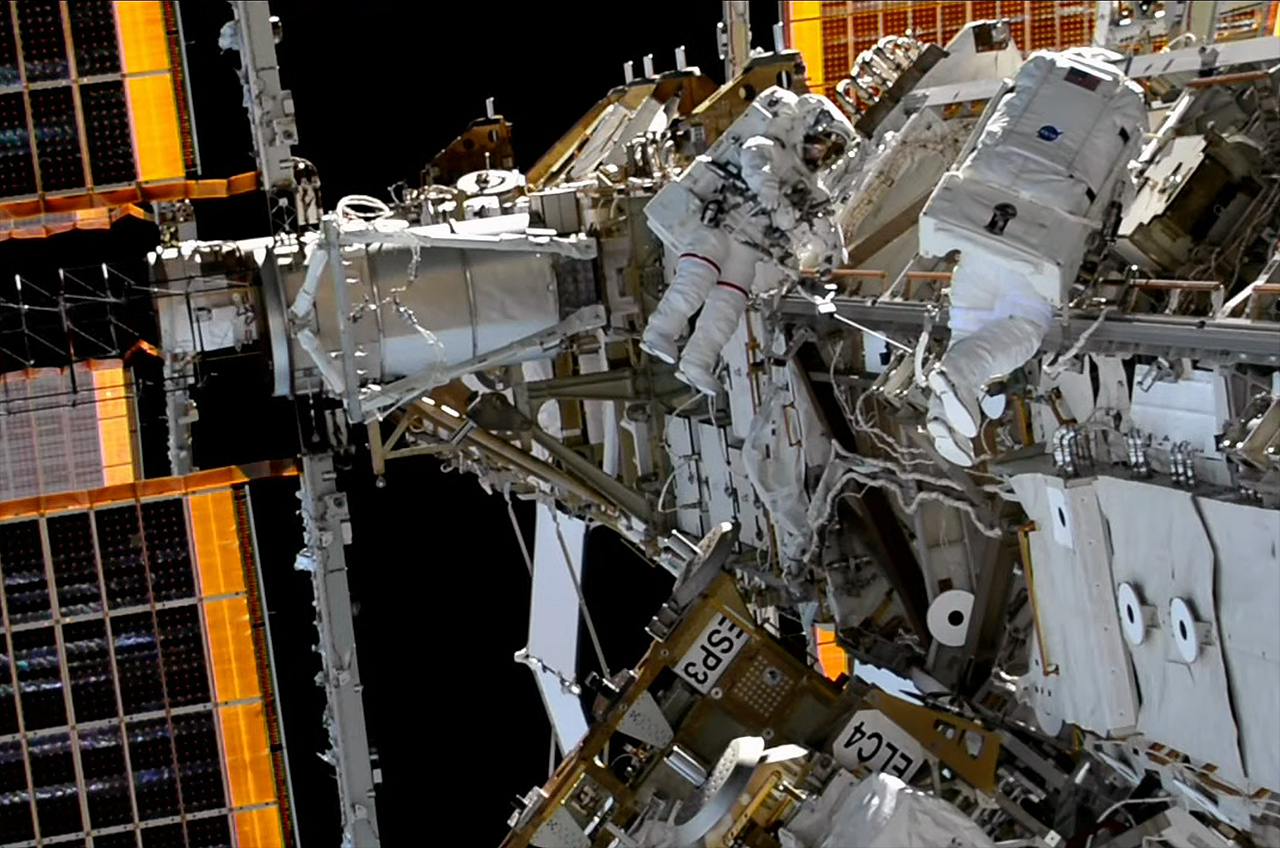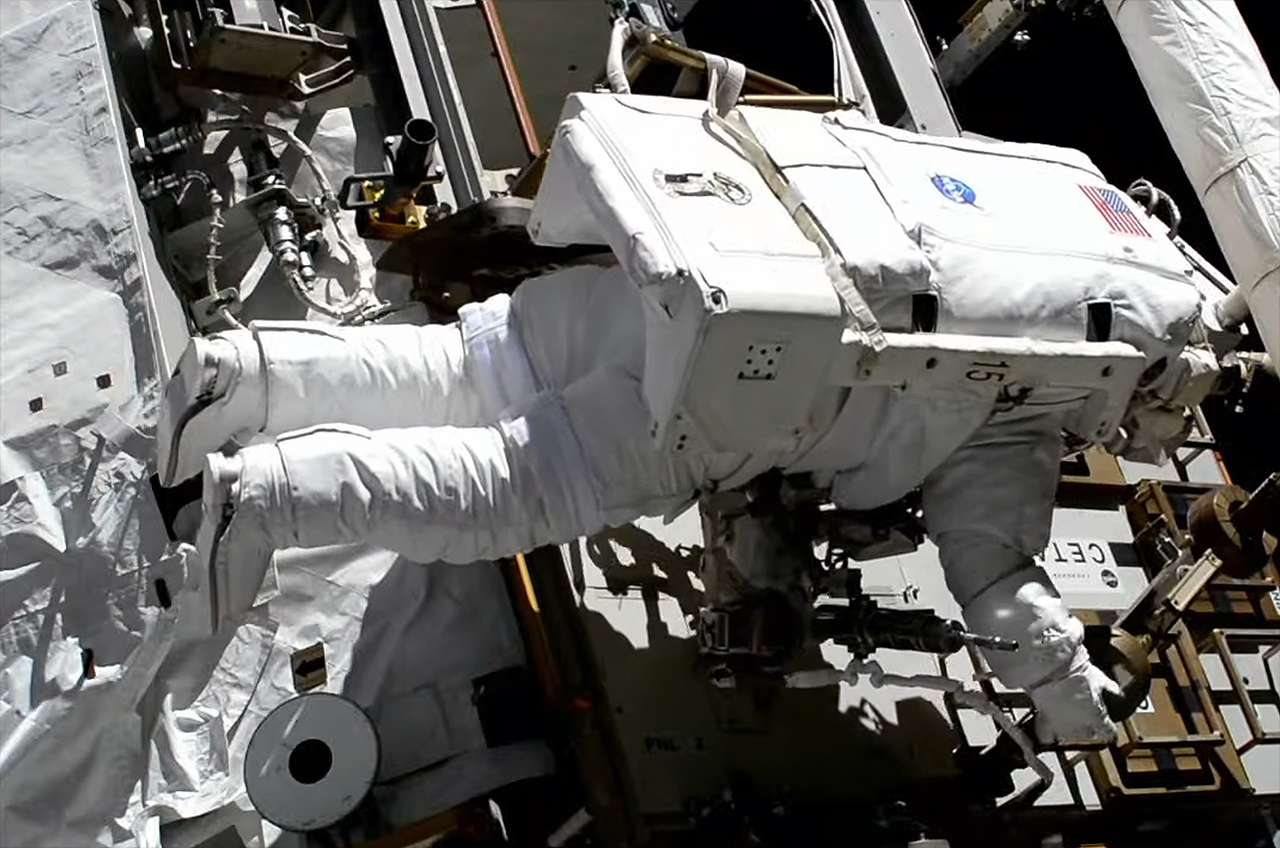With a 'wiggle and nudge,' spacewalking astronauts install stubborn array mount outside space station
"Wow, that worked!"

Proving yet again that if at first you do not succeed, try, try again, two astronauts were finally able to wiggle a stubborn strut into place, completing the installation of a solar array platform that spanned two spacewalks outside the International Space Station.
Nicole Mann of NASA and Koichi Wakata of JAXA (Japan Aerospace Exploration Agency) spent a couple of hours on Thursday (Feb. 2) finishing the work they began last month to erect a support structure for an International Space Station (ISS) Roll-Out Solar Array (iROSA) to be launched later this year. The hold-up, positioning a strut's flat seating plate so that it was flush on a cylindrical canister, was ultimately achieved by the two Expedition 68 crewmates exerting force on either side of the hardware.
"Wow, that worked!" exclaimed Wakata, after trying to position the strut himself using a variety of tools, including a hammer and set of pliers.
"Woo-hoo!" replied Mann, whose contribution was to apply "a gentle jostle" on the strut while applying a steady "yaw maneuver," as advised by Mission Control in Houston.
Related: The most memorable spacewalks of all time in pictures
The successful "nudge and wiggle" occurred just after 10:00 a.m. EST (1500 GMT), about two hours and 15 minutes after Mann and Wakata began the spacewalk, or extravehicular activity (EVA), by taking their spacesuits to battery power and exiting the U.S. Quest airlock.
From there it was mostly a straightforward task to complete the mount, which will support the new iROSA array for the 1A power channel on the starboard side of the station's truss. The two astronauts ran into some minor delays, though, having to remove and reinstall insulation after forgetting to install a pin and dealing with spacesuit issues, including a helmet camera needing to be reset and a brief oxygen level spike that was thought to be a possible glove breach, but was cleared after Wakata inspected the suspect gauntlet.
Get the Space.com Newsletter
Breaking space news, the latest updates on rocket launches, skywatching events and more!
With the "mid-strut" secured in place and a lower strut installed, Wakata and Mann completed the major task of the spacewalk and moved on to some "get-aheads," including relocating a portable foot restraint and replacing the ingress aid for another of the same devices.
After pausing to pose for a few photographs each, Mann and Wakata reentered the airlock and began its re-pressurization at 2:26 p.m. EST (1926 GMT), ending the spacewalk after 6 hours and 41 minutes.

The EVA was the latest in a series devoted to augmenting the space station's power channels with upgraded solar arrays. The iROSA assemblies are being installed in front of, and partially overlying, the orbiting complex's existing, slightly degraded solar panel wings. When used in tandem and once all six iROSAs are in place, the upgraded power system will increase the station's electricity supply by 20% to 30%.
To date, four of the six iROSA assemblies have been deployed and are in working order. The 1A and IB power channels are the last to be augmented.
Thursday's spacewalk was the second for both Mann and Wakata, after their joint excursion on Jan. 20 of this year. Each has now logged 14 hours and 2 minutes working in the vacuum of space. The EVA was the sixth conducted during Expedition 68, the second of the year and 259th in support of ISS assembly and maintenance.
Follow us @Spacedotcom, Facebook and Instagram.
Join our Space Forums to keep talking space on the latest missions, night sky and more! And if you have a news tip, correction or comment, let us know at: community@space.com.

Robert Pearlman is a space historian, journalist and the founder and editor of collectSPACE.com, a daily news publication and community devoted to space history with a particular focus on how and where space exploration intersects with pop culture. Pearlman is also a contributing writer for Space.com and co-author of "Space Stations: The Art, Science, and Reality of Working in Space” published by Smithsonian Books in 2018.In 2009, he was inducted into the U.S. Space Camp Hall of Fame in Huntsville, Alabama. In 2021, he was honored by the American Astronautical Society with the Ordway Award for Sustained Excellence in Spaceflight History. In 2023, the National Space Club Florida Committee recognized Pearlman with the Kolcum News and Communications Award for excellence in telling the space story along the Space Coast and throughout the world.









